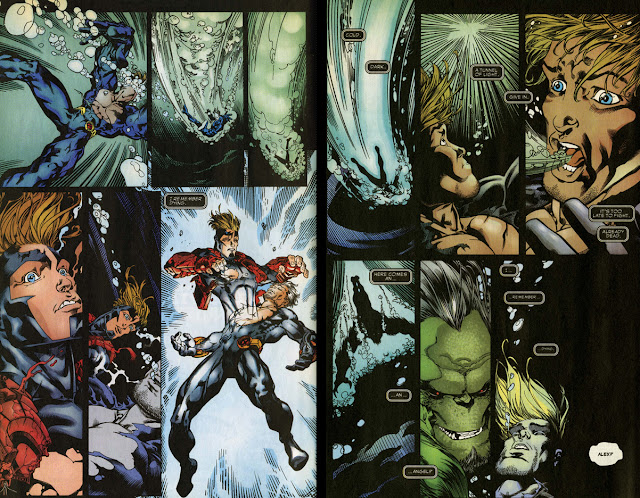I couldn't tell you exactly why this is, but, in the spirit of full disclosure, I collected and read nearly the entire run of Mutant X fresh from the comics rack during its nearly 2½ years of publication, an admission that seems puzzling to me today considering that I can make the same claim about a number of Marvel titles sold during the years 1998-2001. I can state for a fact, however, that my curiosity got the better of me where Mutant X was concerned, given its focus on Havok, the leader of X-Factor who was killed off in the closing pages of that title's final issue, which served to pave the way to the new Mutant X series.
The circumstances involved Havok's attempt to stop Devlin Greystone, a member of X-Factor who constructs a space-time distortion vehicle in order to return "home" (i.e., the same future as Bishop hails from)--yet it turns out Havok has boarded a highly volatile aircraft that doesn't react well to his attempt to disarm it, seemingly killing both men.
I can't say that Greystone thinks much of Mr. Summers' promises right now (assuming the man survived to mull it over). As for Havok, he's subsequently shunted to the new book, where we'll find there are a lot of new things and people to concern him, as a house ad for the series that appears in the X-Factor issue teases:
That book's letters pages had otherwise kept coy about its plans--even up to this point, where they break the news that anyone with X-Factor subscriptions will see them transferred to X-Men. The following month, Mutant X is launched--bringing along Howard Mackie, who had scripted the last thirty-five issues of X-Factor and who would steer the course of Mutant X for the duration.
Going in, we quickly learn that for all intents and purposes, the world of Mutant X is an alternate reality, one where that Earth's Havok, unfortunately, happens to also meet his own death, in this case at the hand of a Sentinel--but his body is salvaged by the essence of the X-Factor member killed by, we should again note, an explosion of a vessel with space-time properties, a description likely meant to justify Havok's transition between worlds and to justify all of the changes we see from this point on.
(I would think the body our Alex Summers is appropriating would still be just as dead or near death from the Sentinel's strike--but apparently my knowledge of space-time assimilations is limited.)
On the Earth that Alex finds himself on, offshoots of the X-Men banded together to become The Six, regarded as heroes by the human race and who are largely credited with forging a peaceful relationship between humans and mutants, an interesting flip of the coin which sees anti-mutant sentiments reduced to fringe groups--most notably S.H.I.E.L.D. (Saviors of Humanity by Intervention in the Evolution of Life-form Deviants), now a terrorist organization led by Nick Fury which conducts operations meant to rally humanity in rising up against mutantkind. These alterations, and more to come, are the linchpin of the book even more than The Six, offering the reader a virtual recreation of the Marvel universe from the ground up as a way to stimulate and hold their interest while stories are weaved around them. (The "Ultimates" books, hitting the stands less than a year after Mutant X ceased publication, would of course take that concept and run with it.)
But when Alex is fished out of the drink by Hank McCoy (the Brute), he understandably doesn't feel compelled in the least to buy what these people are selling, believing all of this to be an elaborate ruse by parties unknown. And so he takes advantage of opportunities to learn more of what's going on here, such as when the Brute inadvertently offers a way for him to play along while he attempts to gather information.
And then there's Madelyne Pryor, "Marvel Woman," who goes into a little more detail about the Six, albeit in scrapbook fashion.
It would be SHIELD's attack and the threat to her son, Scotty, which shows us that Madelyne still embodies the persona and power of the Goblin Queen which we saw during the "Inferno" event. The transformation, however, allows the rest of The Six to regain momentum and turn the tide against the SHIELD forces--while Havok himself acts when the boy is directly threatened. For Madelyne, Alex's action clearly constitutes proof that he's on his way to being "himself" again.
I doubt I can say with certainty that I held genuine interest in Mutant X which motivated me to pick up its issues diligently, given that I was probably on auto-pilot at the time when it came to comics collecting and reading; but this opening issue was enough to hook me, and I stuck with it. Curiously enough, I pulled out of this series with its penultimate issue--probably because of the teaser caption in that year's Mutant X Annual which served as the final story's lead-in, wording that used shock value to make the sale and consequently caused me to reject it out of hand.















Ugh, the 90s - the Distorted Anatomy Age. I stuck close to home in my reading, especially in the second half of that decade, with titles like Avengers which I'd been reading since the early 70s. Even that book didn't guarantee great stories but I felt comfortable with the characters. I'd left the X-Titles behind years earlier when they became too prolific.
ReplyDeleteAhh, charliedogg, so you'll recall this jaw-dropping moment that the '90s Avengers laid on us, just a few issues before Avengers Vol. 1 came to a close. It made me think that the Onslaught attack might have been a blessing in terms of a reset.
ReplyDelete